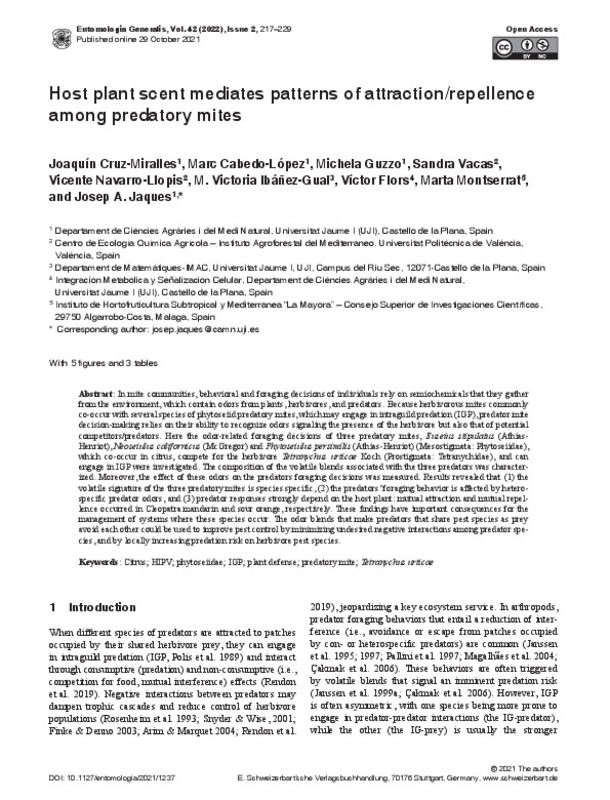JavaScript is disabled for your browser. Some features of this site may not work without it.
Buscar en RiuNet
Listar
Mi cuenta
Estadísticas
Ayuda RiuNet
Admin. UPV
Host plant scent mediates patterns of attraction/repellence among predatory mites
Mostrar el registro sencillo del ítem
Ficheros en el ítem
| dc.contributor.author | Cruz-Miralles, Joaquin
|
es_ES |
| dc.contributor.author | Cabedo-Lopez, Marc
|
es_ES |
| dc.contributor.author | Guzzo, Michela
|
es_ES |
| dc.contributor.author | Vacas, Sandra
|
es_ES |
| dc.contributor.author | Navarro-Llopis, Vicente
|
es_ES |
| dc.contributor.author | Ibáñez-Gual, M. Victoria
|
es_ES |
| dc.contributor.author | Flors, Victor
|
es_ES |
| dc.contributor.author | Montserrat, Marta
|
es_ES |
| dc.contributor.author | Jaques, Josep A.
|
es_ES |
| dc.date.accessioned | 2022-04-27T10:07:14Z | |
| dc.date.available | 2022-04-27T10:07:14Z | |
| dc.date.issued | 2022 | es_ES |
| dc.identifier.issn | 0171-8177 | es_ES |
| dc.identifier.uri | http://hdl.handle.net/10251/182185 | |
| dc.description.abstract | [EN] In mite communities, behavioral and foraging decisions of individuals rely on semiochemicals that they gather from the environment, which contain odors from plants, herbivores, and predators. Because herbivorous mites commonly co-occur with several species of phytoseiid predatory mites, which may engage in intraguild predation (IGP), predator mite decision-making relies on their ability to recognize odors signaling the presence of the herbivore but also that of potential competitors/predators. Here the odor-related foraging decisions of three predatory mites, Euseius stipulatus (Athias-Henriot), Neoseiulus californicus (McGregor) and Phytoseiulus persimilis (Athias-Henriot) (Mesostigmata: Phytoseiidae), which co-occur in citrus, compete for the herbivore Tetranychus urticae Koch (Prostigmata: Tetranychidae), and can engage in IGP were investigated. The composition of the volatile blends associated with the three predators was characterized. Moreover, the effect of these odors on the predators foraging decisions was measured. Results revealed that (1) the volatile signature of the three predatory mites is species specific, (2) the predators¿ foraging behavior is affected by heterospecific predator odors, and (3) predator responses strongly depend on the host plant: mutual attraction and mutual repellence occurred in Cleopatra mandarin and sour orange, respectively. These findings have important consequences for the management of systems where these species occur. The odor blends that make predators that share pest species as prey avoid each other could be used to improve pest control by minimizing undesired negative interactions among predator species, and by locally increasing predation risk on herbivore pest species. | es_ES |
| dc.description.sponsorship | The authors thank M. Piquer (UJI) for technical assistance and J. Calvo (Koppert Biological Systems) for the supply of N. californicus and P. persimilis. This study was partially funded by the Spanish Research State Agency (research grants AGL2014-55616-C3, AGL2015-64990-2R, PID2019-103863RB-I00 and BES-2015-074570). | es_ES |
| dc.language | Inglés | es_ES |
| dc.publisher | Schweizerbart | es_ES |
| dc.relation.ispartof | Entomologia Generalis | es_ES |
| dc.rights | Reserva de todos los derechos | es_ES |
| dc.subject | Citrus | es_ES |
| dc.subject | HIPV | es_ES |
| dc.subject | Phytoseiidae | es_ES |
| dc.subject | IGP | es_ES |
| dc.subject | Plant defense | es_ES |
| dc.subject | Predatory mite | es_ES |
| dc.subject | Tetranychus urticae | es_ES |
| dc.title | Host plant scent mediates patterns of attraction/repellence among predatory mites | es_ES |
| dc.type | Artículo | es_ES |
| dc.identifier.doi | 10.1127/entomologia/2021/1237 | es_ES |
| dc.relation.projectID | info:eu-repo/grantAgreement/AEI/Plan Estatal de Investigación Científica y Técnica y de Innovación 2017-2020/PID2019-103863RB-I00/ES/LOS EFECTOS DE DERRAME DE LOS DEPREDADORES DESDE LAS ISLAS DE RECURSOS A LOS ECOSISTEMAS CIRCUNDANTES/ | es_ES |
| dc.relation.projectID | info:eu-repo/grantAgreement/MINECO//AGL2014-55616-C3-2-R/ES/MEJORA DE LA RESILIENCIA DEL CULTIVO MEDIANTE LA SELECCION DE ENEMIGOS NATURALES MEJOR ADAPTADOS AL CAMBIO CLIMATICO/ | es_ES |
| dc.relation.projectID | info:eu-repo/grantAgreement/MINECO//AGL2015-64990-C2-2-R/ES/SEÑALIZACION SISTEMICA EN RESISTENCIA INDUCIDA POR MICORRIZAS ARBUSCULARES. IMPLICACIONES PARA EL CULTIVO DEL TOMATE/ | es_ES |
| dc.relation.projectID | info:eu-repo/grantAgreement/MINECO//BES-2015-074570/ES/BES-2015-074570/ | es_ES |
| dc.rights.accessRights | Abierto | es_ES |
| dc.contributor.affiliation | Universitat Politècnica de València. Instituto Agroforestal Mediterráneo - Institut Agroforestal Mediterrani | es_ES |
| dc.description.bibliographicCitation | Cruz-Miralles, J.; Cabedo-Lopez, M.; Guzzo, M.; Vacas, S.; Navarro-Llopis, V.; Ibáñez-Gual, MV.; Flors, V.... (2022). Host plant scent mediates patterns of attraction/repellence among predatory mites. Entomologia Generalis. 42(2):217-229. https://doi.org/10.1127/entomologia/2021/1237 | es_ES |
| dc.description.accrualMethod | S | es_ES |
| dc.relation.publisherversion | https://doi.org/10.1127/entomologia/2021/1237 | es_ES |
| dc.description.upvformatpinicio | 217 | es_ES |
| dc.description.upvformatpfin | 229 | es_ES |
| dc.type.version | info:eu-repo/semantics/publishedVersion | es_ES |
| dc.description.volume | 42 | es_ES |
| dc.description.issue | 2 | es_ES |
| dc.relation.pasarela | S\459921 | es_ES |
| dc.contributor.funder | Agencia Estatal de Investigación | es_ES |
| dc.contributor.funder | Ministerio de Economía y Competitividad | es_ES |








